light TOYOTA PRIUS PLUG-IN HYBRID 2014 1.G Quick Reference Guide
[x] Cancel search | Manufacturer: TOYOTA, Model Year: 2014, Model line: PRIUS PLUG-IN HYBRID, Model: TOYOTA PRIUS PLUG-IN HYBRID 2014 1.GPages: 40, PDF Size: 4.58 MB
Page 2 of 40
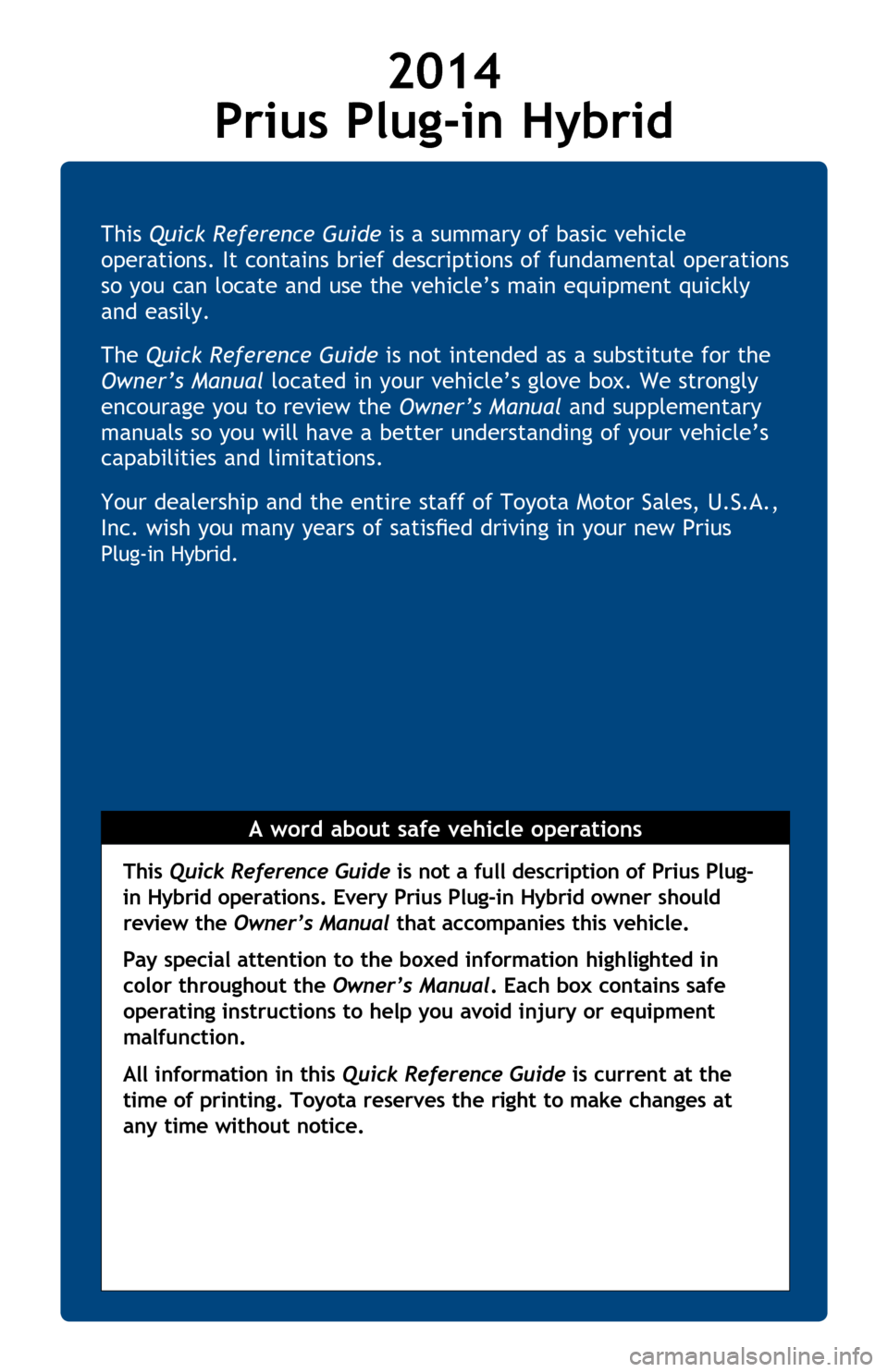
This Quick Reference Guide is a summary of basic vehicle
operations. It contains brief descriptions of fundamental operations
so you can locate and use the vehicle’s main equipment quickly
and easily.
The Quick Reference Guide is not intended as a substitute for the
Owner’s Manual located in your vehicle’s glove box. We strongly
encourage you to review the Owner’s Manual and supplementary
manuals so you will have a better understanding of your vehicle’s
capabilities and limitations.
Your dealership and the entire staff of Toyota Motor Sales, U.S.A.,
Inc. wish you many years of satisfied driving in your new Prius
Plug-in Hybrid
.
A word about safe vehicle operations
This Quick Reference Guide is not a full description of Prius Plug-
in Hybrid operations. Every Prius Plug-in Hybrid owner should
review the Owner’s Manual that accompanies this vehicle.
Pay special attention to the boxed information highlighted in
color throughout the Owner’s Manual. Each box contains safe
operating instructions to help you avoid injury or equipment
malfunction.
All information in this Quick Reference Guide is current at the
time of printing. Toyota reserves the right to make changes at
any time without notice.
2014
Prius Plug-in Hybrid
Page 3 of 40
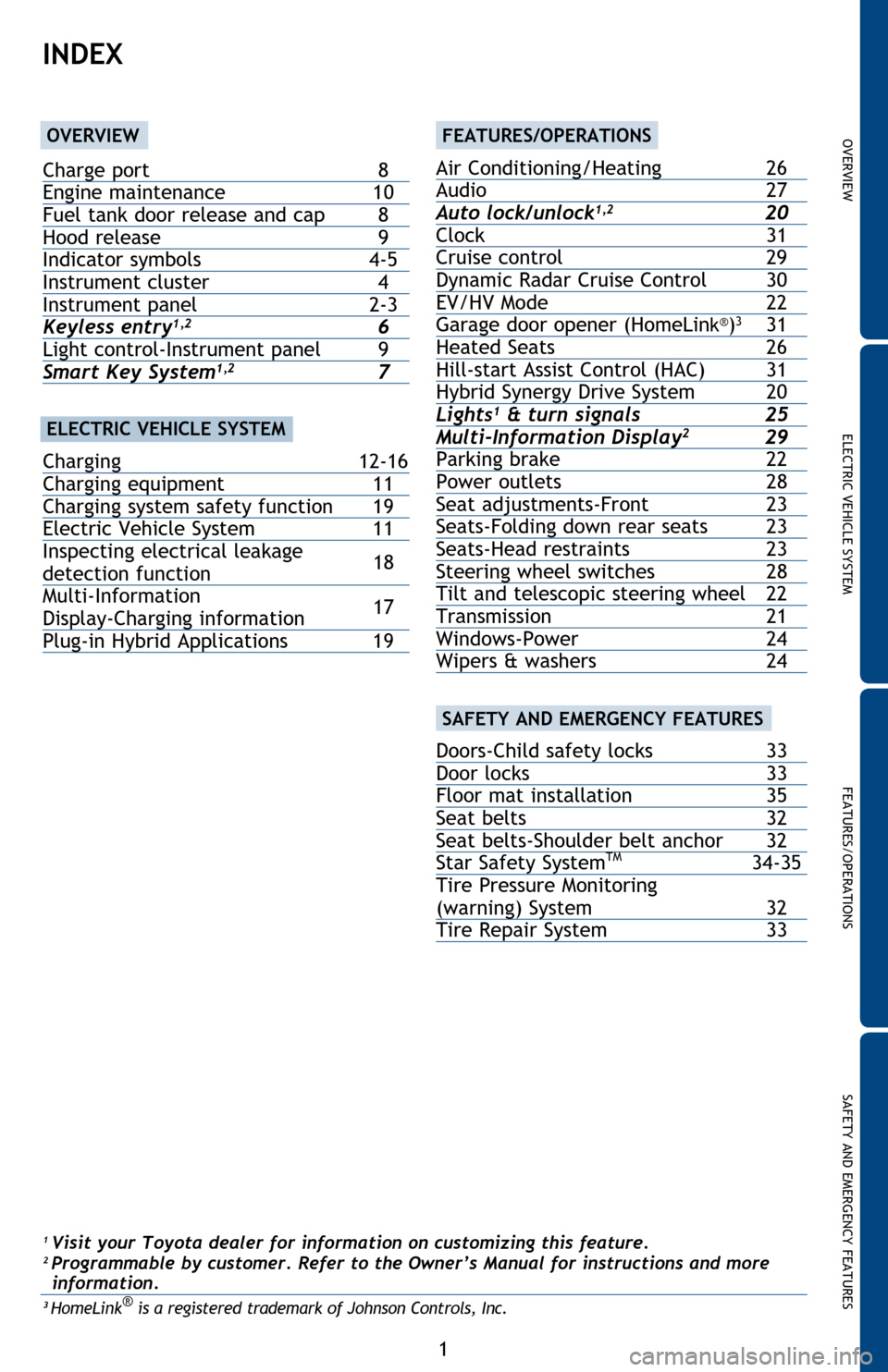
1
INDEX
1 Visit your Toyota dealer for information on customizing this feature.2 Programmable by customer. Refer to the Owner’s Manual for instructions and more information.
3 HomeLink® is a registered trademark of Johnson Controls, Inc.
OVERVIEWFEATURES/OPERATIONS
Air Conditioning/Heating 26
Audio 27
Auto lock/unlock
1,2 20
Clock 31
Cruise control 29
Dynamic Radar Cruise Control 30
EV/HV Mode 22
Garage door opener (HomeLin
k®)3 31
Heated Seats 26
Hill-start Assist Control (HAC) 31Hybrid Synergy Drive System 20
Lights1 & turn signals 25
Multi-Information Display2 29
Parking brake 22
Power outlets 28
Seat adjustments-Front 23
Seats-Folding down rear seats 23
Seats-Head restraints 23
Steering wheel switches 28
Tilt and telescopic steering wheel 22
Transmission 21
Windows-Power 24
Wipers & washers 24
Doors-Child safety locks 33
Door locks 33
Floor mat installation 35
Seat belts 32
Seat belts-Shoulder belt anchor 32
Star Safety System
TM 34-35
Tire Pressure Monitoring
(warning) System 32
Tire Repair System 33
Charge port 8
Engine maintenance 10
Fuel tank door release and cap 8
Hood release 9
Indicator symbols 4-5
Instrument cluster 4
Instrument panel
2-3Keyless entry1,2 6
Light control-Instrument panel 9
Smart Key System1,2 7
Charging 12-16
Charging equipment 11
Charging system safety function 19
Electric Vehicle System 11
Inspecting electrical leakage
detection function
Multi-Information
Display-Charging information
Plug-in Hybrid Applications 19
17 18
ELECTRIC VEHICLE SYSTEM
SAFETY AND EMERGENCY FEATURES
OVERVIEWELECTRIC VEHICLE SYSTEM FEATURES/OPERATIONS
SAFETY AND EMERGENCY FEATURES
Page 4 of 40
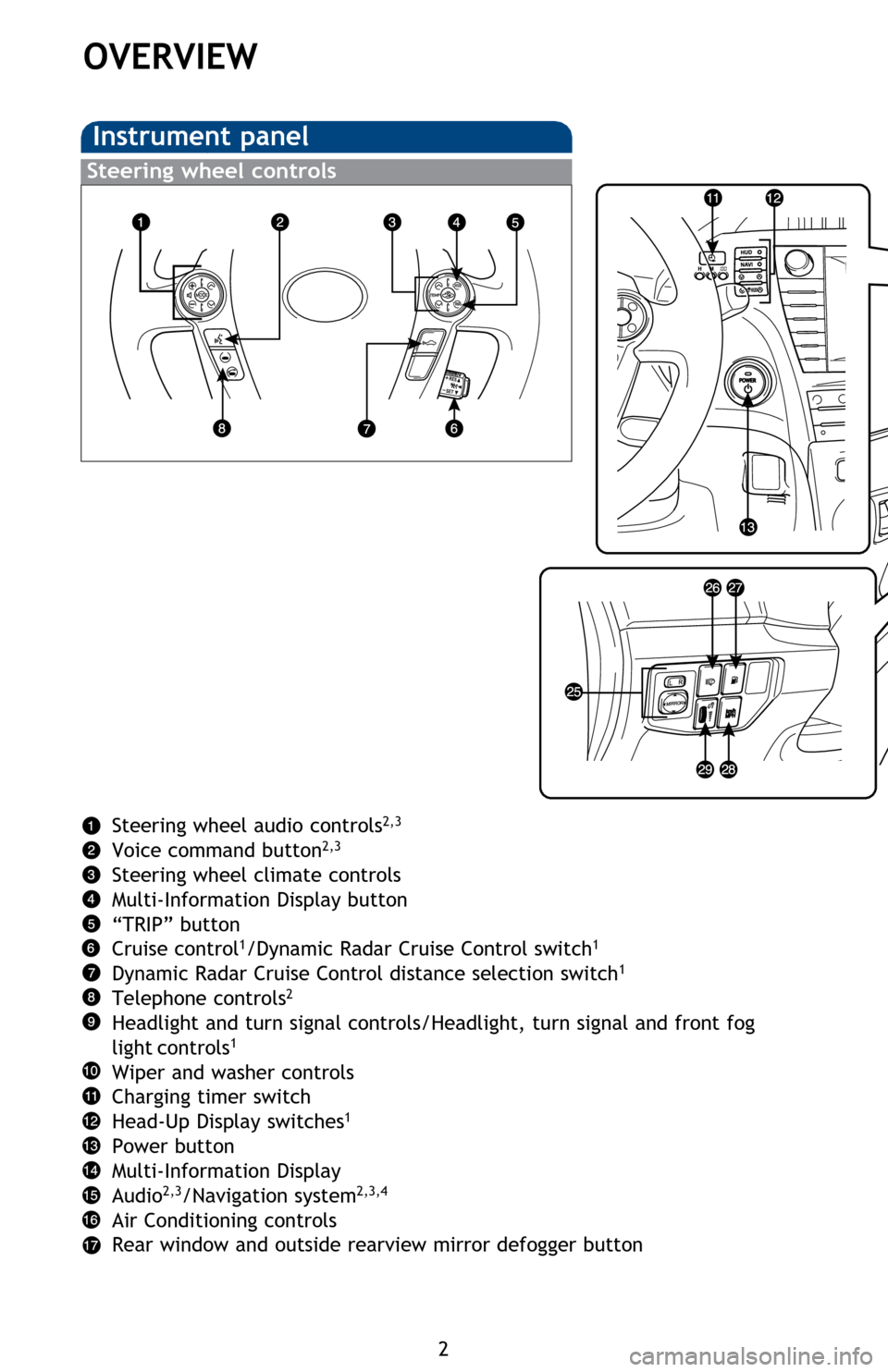
2
OVERVIEW
Instrument panel
Steering wheel controls
Steering wheel audio controls2,3
Voice command button2,3
Steering wheel climate controls
Multi-Information Display button
“TRIP” button
Cruise control
1/Dynamic Radar Cruise Control switch1
Dynamic Radar Cruise Control distance selection switch1
Telephone controls2
Headlight and turn signal controls/Headlight, turn signal and front fog
light controls1
Wiper and washer controls
Charging timer switch
Head-Up Display switches
1
Power button
Multi-Information Display
Audio
2,3/Navigation system2,3,4
Air Conditioning controls
Rear window and outside rearview mirror defogger button
Page 5 of 40
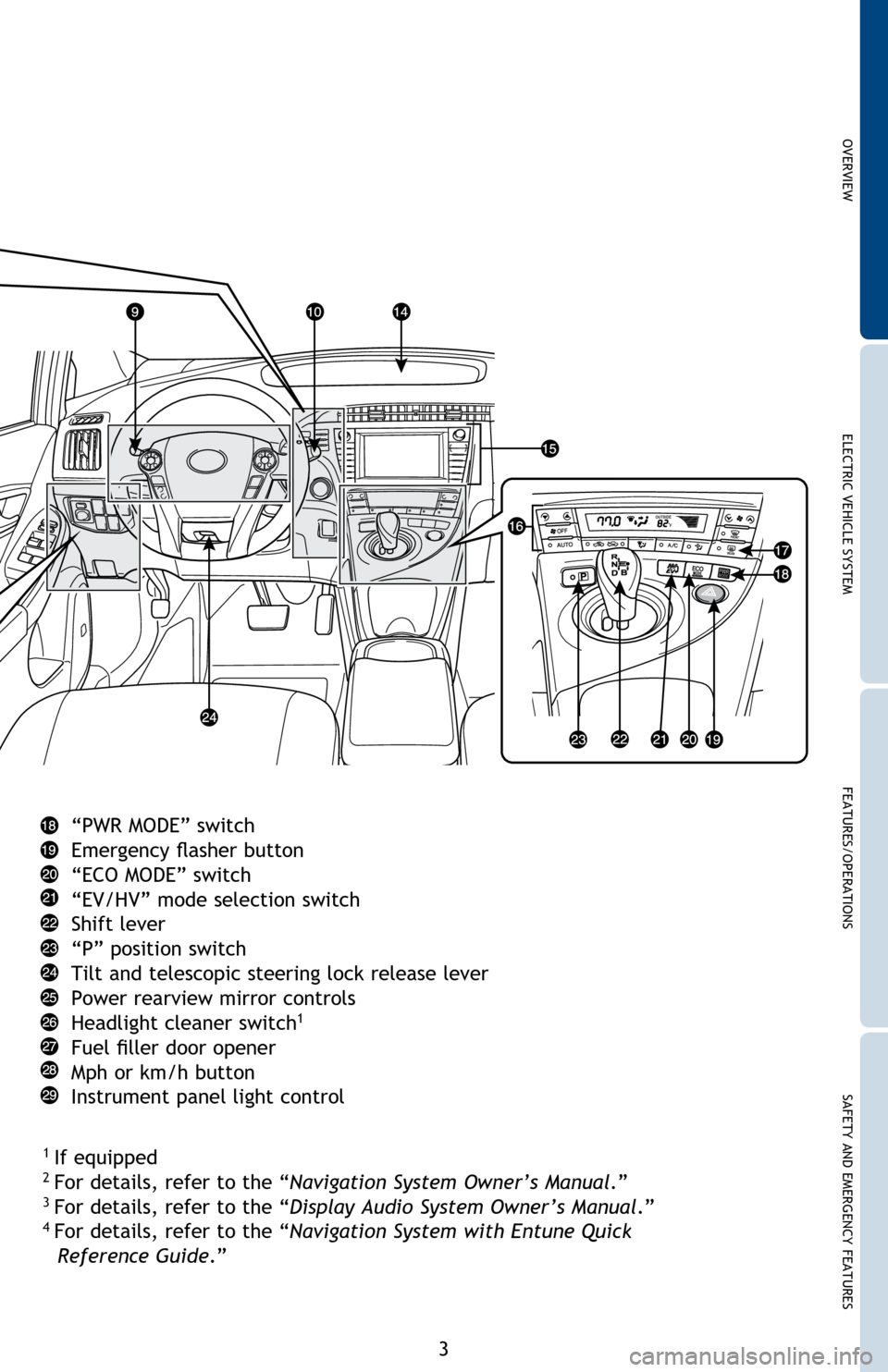
3
“PWR MODE” switch
Emergency flasher button
“ECO MODE” switch
“EV/HV” mode selection switch
Shift lever
“P” position switch
Tilt and telescopic steering lock release lever
Power rearview mirror controls
Headlight cleaner switch
1
Fuel filler door opener
Mph or km/h button
Instrument panel light control
1 If equipped2 For details, refer to the “Navigation System Owner’s Manual.”3 For details, refer to the “Display Audio System Owner’s Manual .”4
For details, refer to the “Navigation System with Entune Quick
Reference Guide.”
OVERVIEWELECTRIC VEHICLE SYSTEM FEATURES/OPERATIONS
SAFETY AND EMERGENCY FEATURES
Page 6 of 40
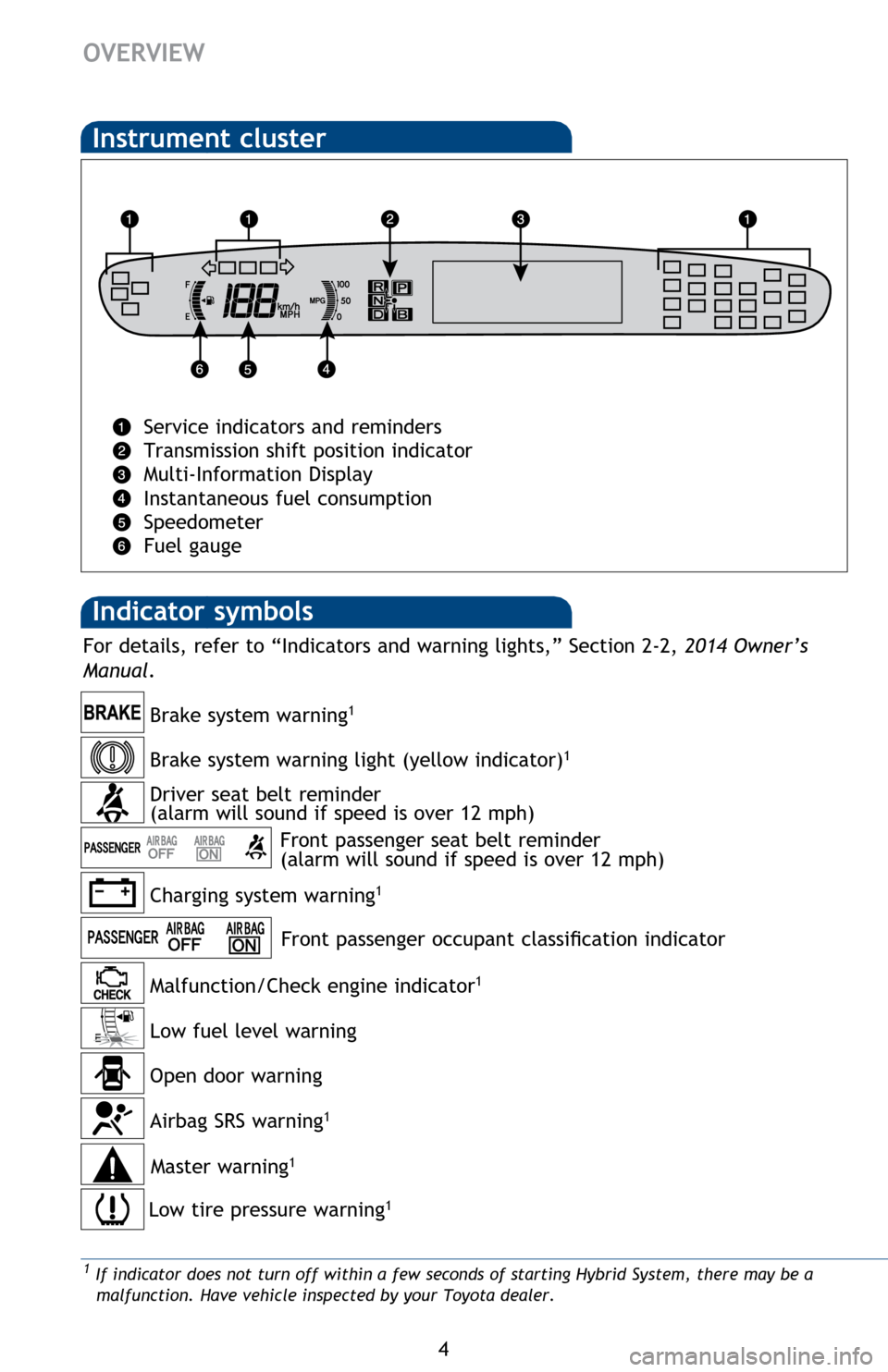
4
OVERVIEW
Indicator symbols
Instrument cluster
Service indicators and reminders
Transmission shift position indicator
Multi-Information Display
Instantaneous fuel consumption
Speedometer
Fuel gauge
Charging system warning1
Brake system warning1
Front passenger occupant classification indicator
Low tire pressure warning1
Open door warning
Airbag SRS warning1
Master warning1
Driver seat belt reminder
(alarm will sound if speed is over 12 mph)Front passenger seat belt reminder
(alarm will sound if speed is over 12 mph)
Malfunction/Check engine indicator
1
Low fuel level warning
Brake system warning light (yellow indicator)1
1
If indicator does not turn off within a few seconds of starting Hybrid System, there may be a
malfunction. Have vehicle inspected by your Toyota dealer.
For details, refer to “Indicators and warning lights,” Section 2-2, 2014 Owner’s
Manual .
Page 7 of 40
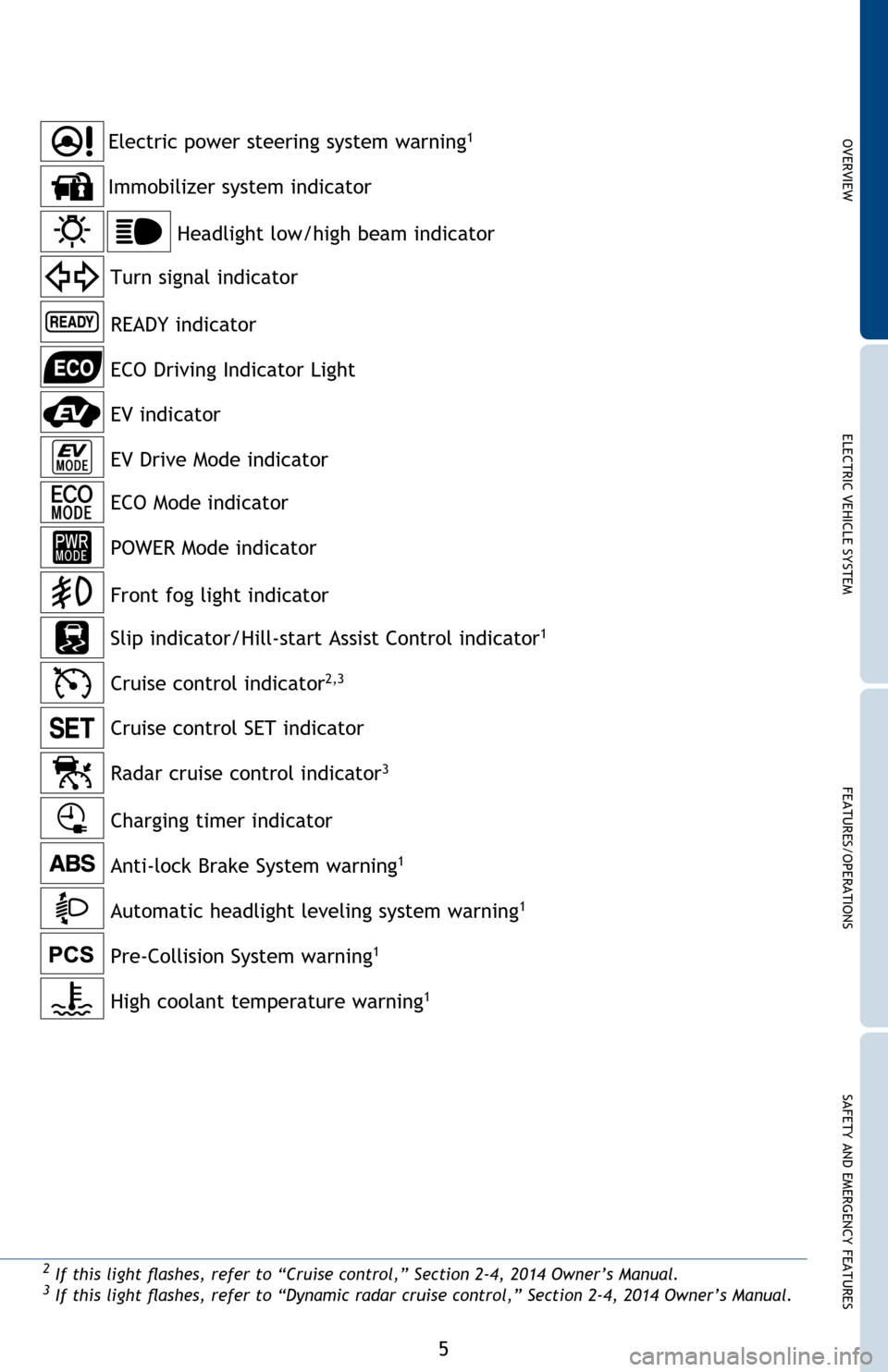
5
2 If this light flashes, refer to “Cruise control,” Section 2-4, 2014 Owner’s Manual.3 If this light flashes, refer to “Dynamic radar cruise control,” Section 2-4, 2014 Owner’s Manual.
Anti-lock Brake System warning1
Headlight low/high beam indicator
Turn signal indicator
Slip indicator/Hill-start Assist Control indicator
1
Cruise control indicator2,3
Cruise control SET indicator
Radar cruise control indicator
3
Immobilizer system indicator
Electric power steering system warning1
READY indicator
Front fog light indicator
ECO Mode indicator
EV Drive Mode indicator
Automatic headlight leveling system warning
1
Charging timer indicator
Pre-Collision System warning1
High coolant temperature warning1
POWER Mode indicator
ECO Driving Indicator Light
EV indicator
OVERVIEWELECTRIC VEHICLE SYSTEM FEATURES/OPERATIONS
SAFETY AND EMERGENCY FEATURES
Page 11 of 40

9
Hood release
Pull up latch and
raise hood
Light control-Instrument panel
Brightness
control
-
+
Engage support rod
Pull
OVERVIEWELECTRIC VEHICLE SYSTEM FEATURES/OPERATIONS
SAFETY AND EMERGENCY FEATURES
Page 14 of 40
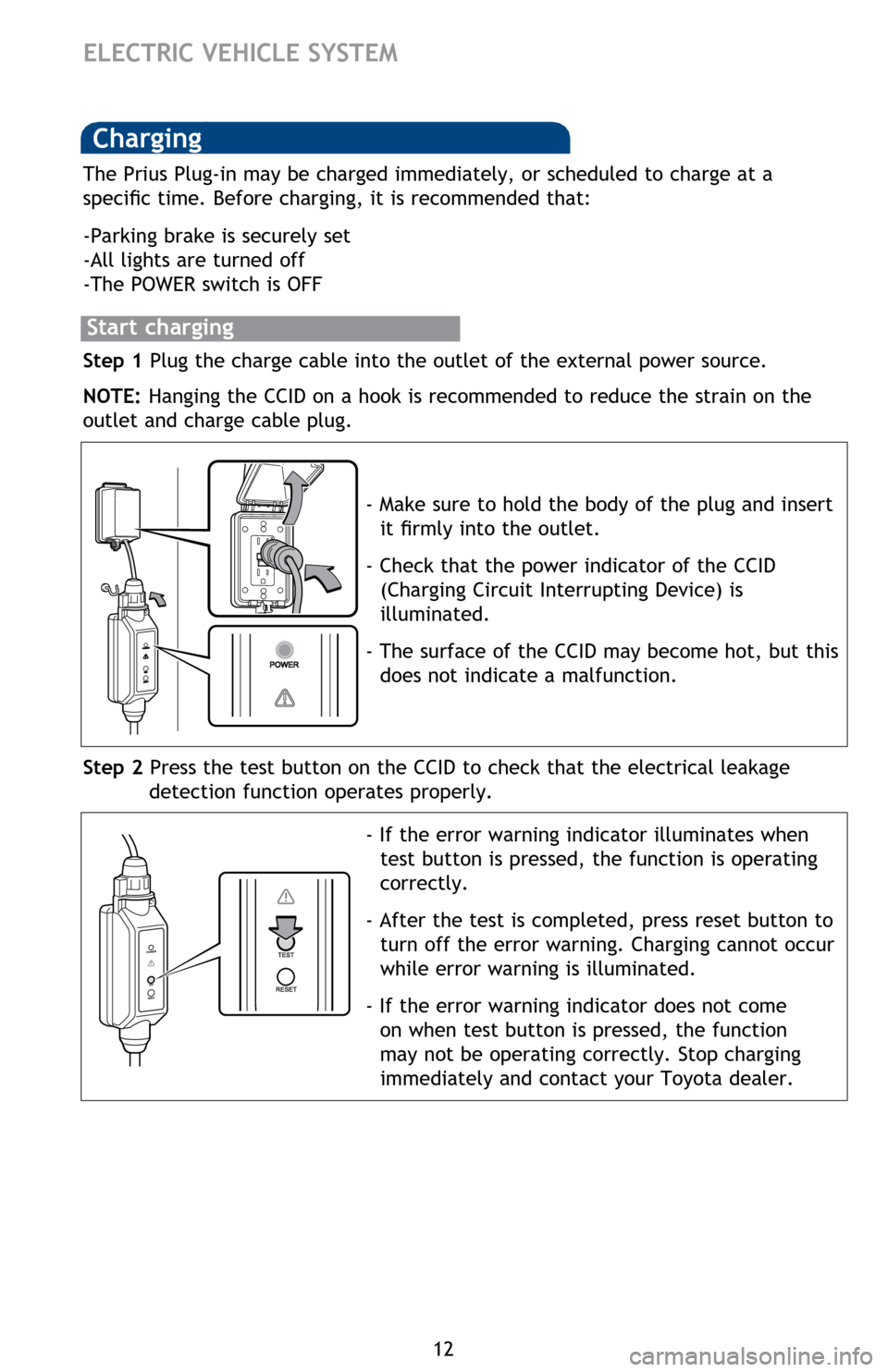
12
ELECTRIC VEHICLE SYSTEM
Charging
Step 1 Plug the charge cable into the outlet of the external power source.
NOTE: Hanging the CCID on a hook is recommended to reduce the strain on the
outlet and charge cable plug.
- Make sure to hold the body of the plug and insert it firmly into the outlet.
- Check that the power indicator of the CCID (Charging Circuit Interrupting Device) is
illuminated.
- The surface of the CCID may become hot, but this does not indicate a malfunction.
Step 2 Press the test button on the CCID to check that the electrical leakage detection function operates properly.
- If the error warning indicator illuminates when test button is pressed, the function is operating
correctly.
- After the test is completed, press reset button to turn off the error warning. Charging cannot occur
while error warning is illuminated.
- If the error warning indicator does not come on when test button is pressed, the function
may not be operating correctly. Stop charging
immediately and contact your Toyota dealer.
The Prius Plug-in may be charged immediately, or scheduled to charge at a
specific time. Before charging, it is recommended that:
-Parking brake is securely set
-All lights are turned off
-The POWER switch is OFF
Start charging
Page 15 of 40
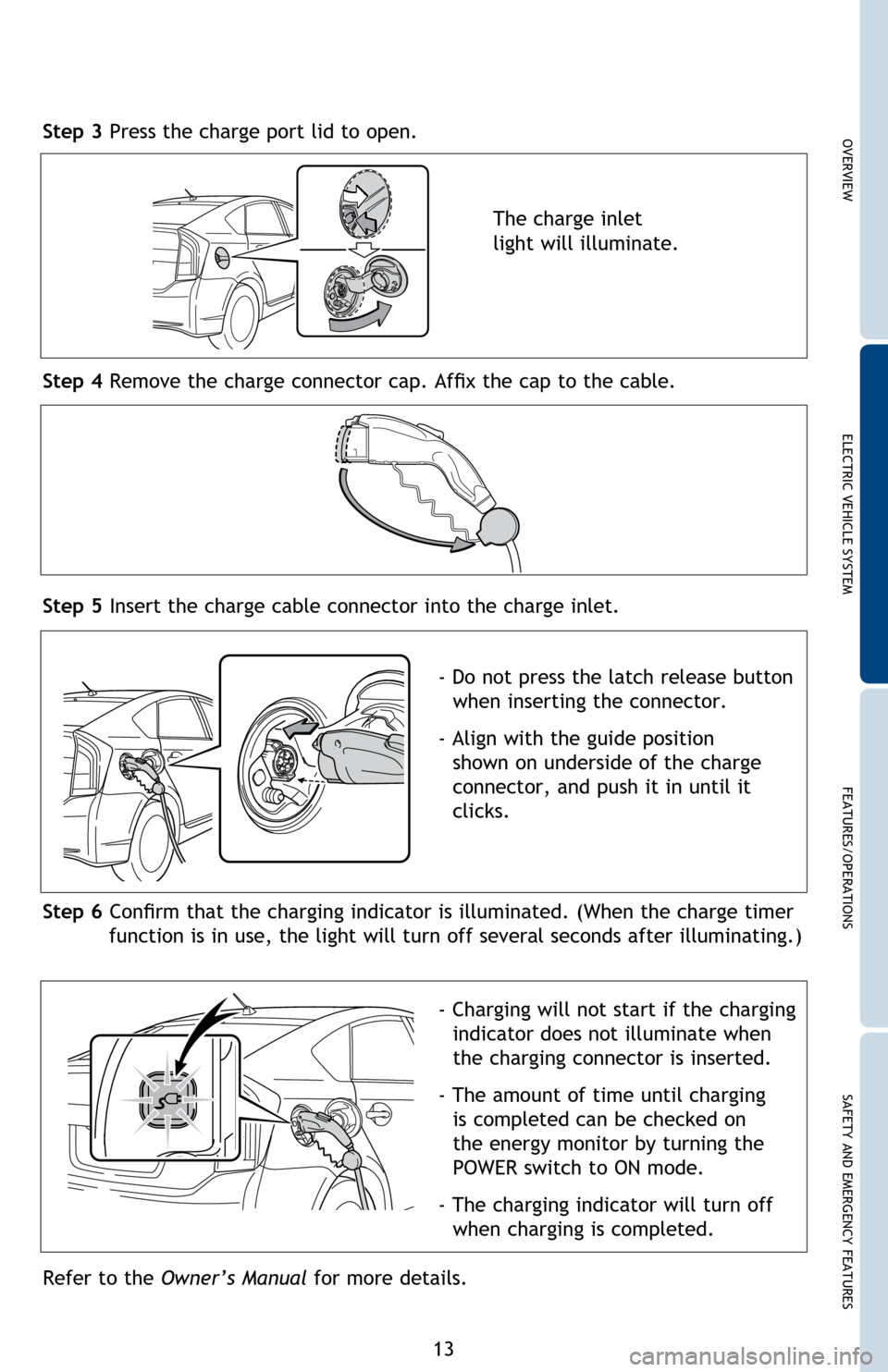
13
Step 3 Press the charge port lid to open.
Step 4 Remove the charge connector cap. Affix the cap to the cable.
The charge inlet
light will illuminate.
Step 5 Insert the charge cable connector into the charge inlet.
- Do not press the latch release button when inserting the connector.
- Align with the guide position shown on underside of the charge
connector, and push it in until it
clicks.
Step 6 Confirm that the charging indicator is illuminated. (When the charge timer function is in use, the light will turn off several seconds after illuminating.)
- Charging will not start if the charging indicator does not illuminate when
the charging connector is inserted.
- The amount of time until charging is completed can be checked on
the energy monitor by turning the
POWER switch to ON mode.
- The charging indicator will turn off when charging is completed.
Refer to the Owner’s Manual for more details.
OVERVIEWELECTRIC VEHICLE SYSTEM FEATURES/OPERATIONS
SAFETY AND EMERGENCY FEATURES
Page 22 of 40
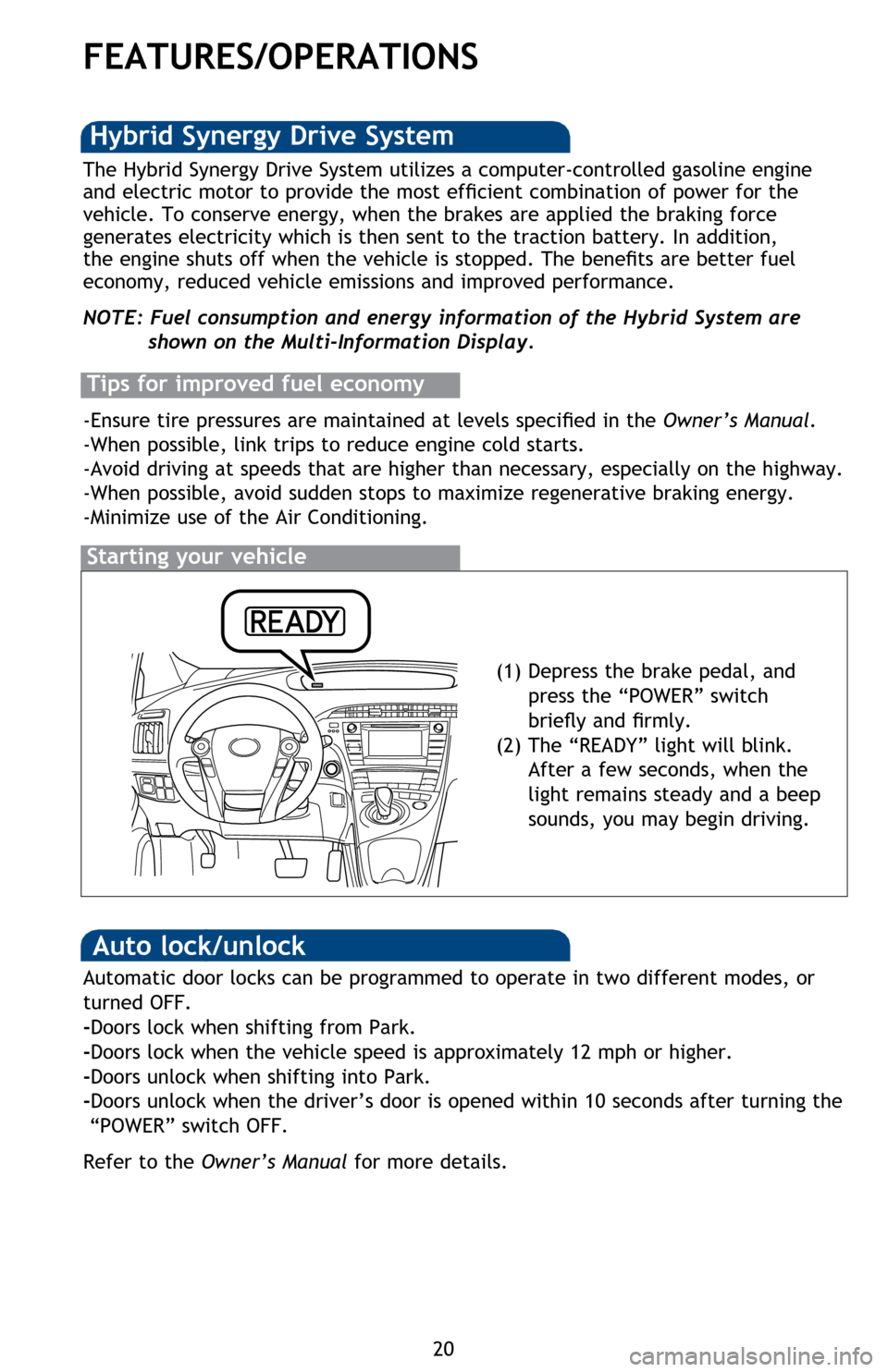
20
FEATURES/OPERATIONS
Starting your vehicle
The Hybrid Synergy Drive System utilizes a computer-controlled gasoline engine
and electric motor to provide the most efficient combination of power for the
vehicle. To conserve energy, when the brakes are applied the braking force
generates electricity which is then sent to the traction battery. In addition,
the engine shuts off when the vehicle is stopped. The benefits are better fuel
economy, reduced vehicle emissions and improved performance.
NOTE: Fuel consumption and energy information of the Hybrid System are shown on the Multi-Information Display.
Tips for improved fuel economy
-Ensure tire pressures are maintained at levels specified in the Owner’s Manual.
-When possible, link trips to reduce engine cold starts.
-Avoid driving at speeds that are higher than necessary, especially on the highway.
-When possible, avoid sudden stops to maximize regenerative braking energy.
-Minimize use of the Air Conditioning.
Hybrid Synergy Drive System
Auto lock/unlock
Automatic door locks can be programmed to operate in two different modes, or
turned OFF.
-Doors lock when shifting from Park.
-Doors lock when the vehicle speed is approximately 12 mph or higher.
-Doors unlock when shifting into Park.
-Doors unlock when the driver’s door is opened within 10 seconds after turning the
“POWER” switch OFF.
Refer to the Owner’s Manual for more details. (1) Depress the brake pedal, and
press the “POWER” switch
briefly and firmly.
(2) The “READY” light will blink. After a few seconds, when the
light remains steady and a beep
sounds, you may begin driving.